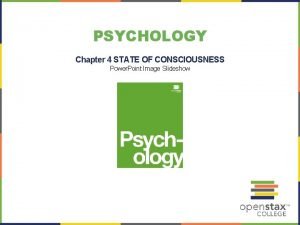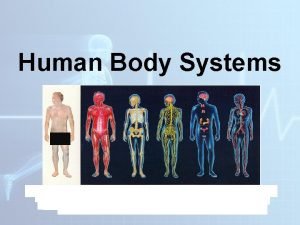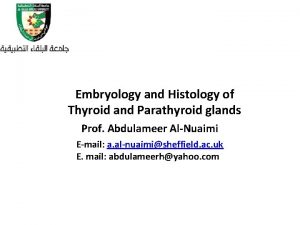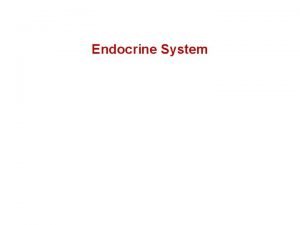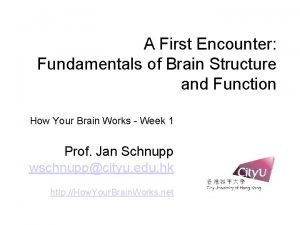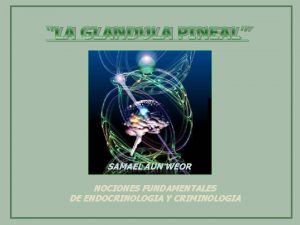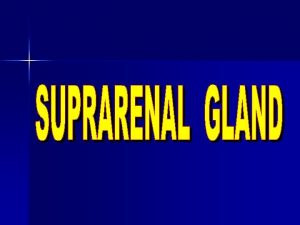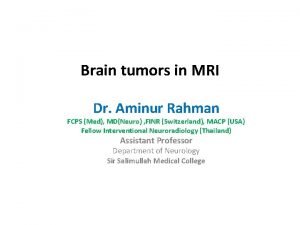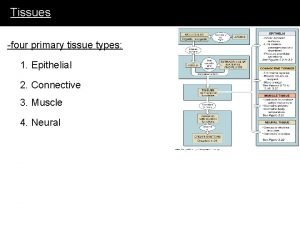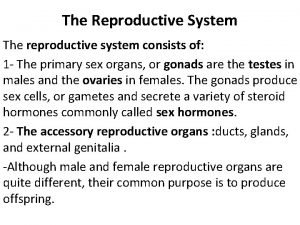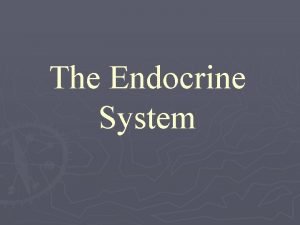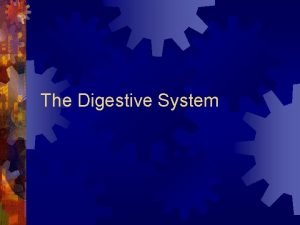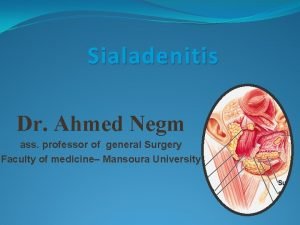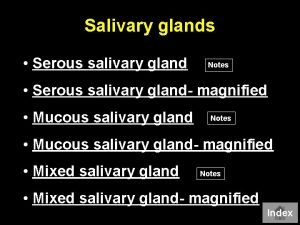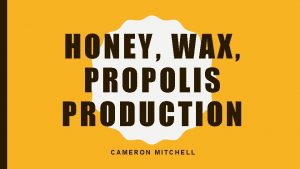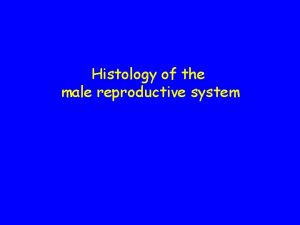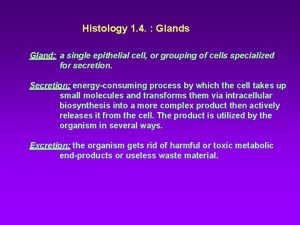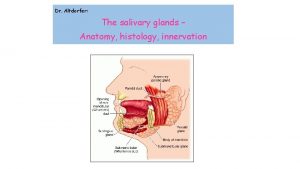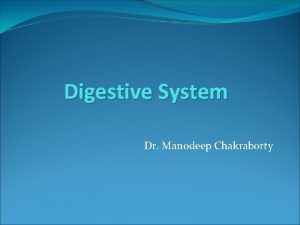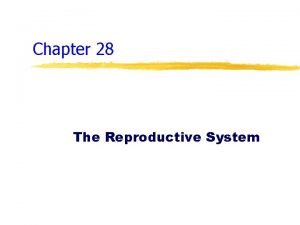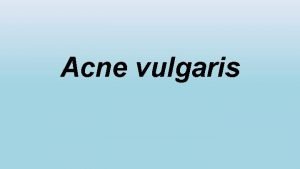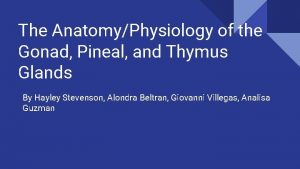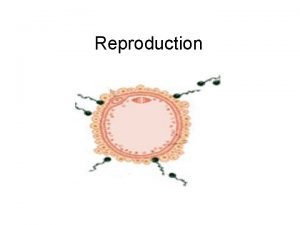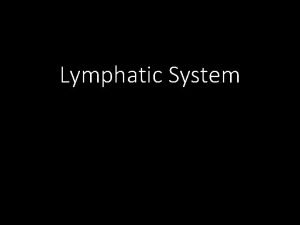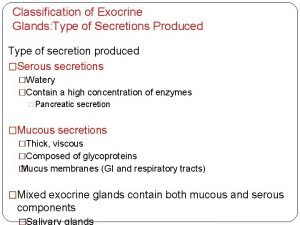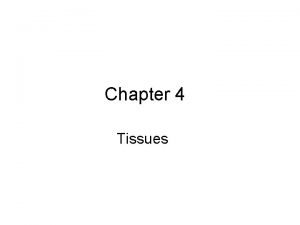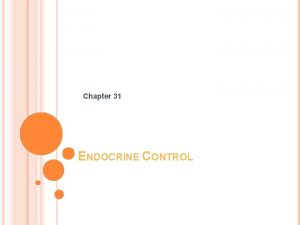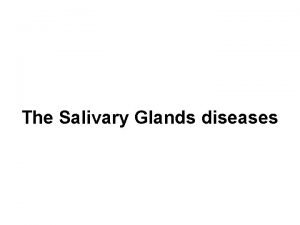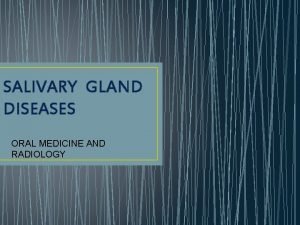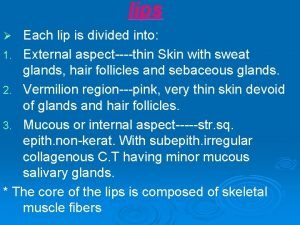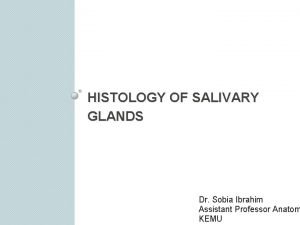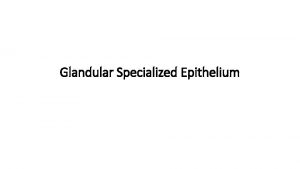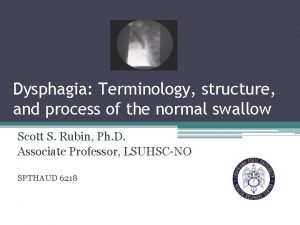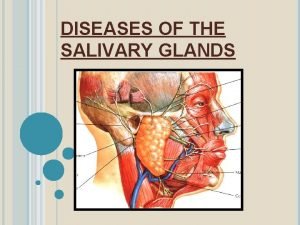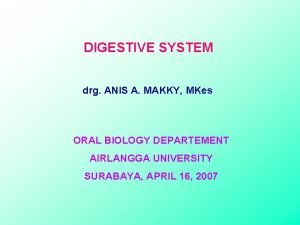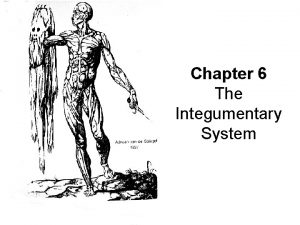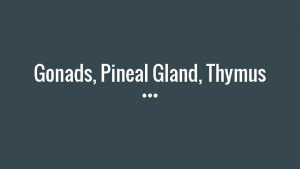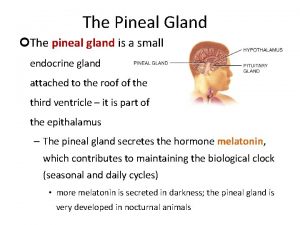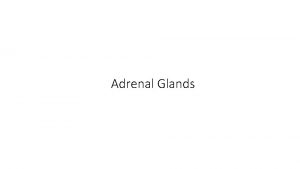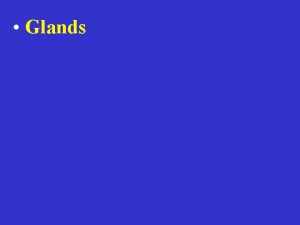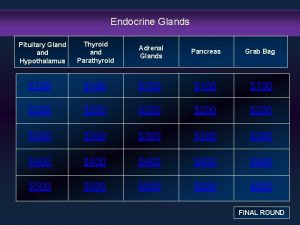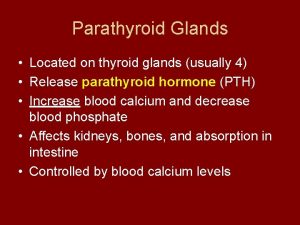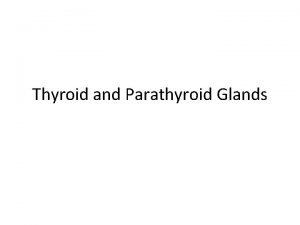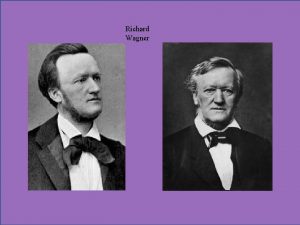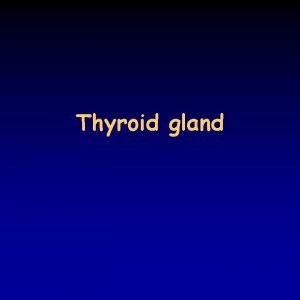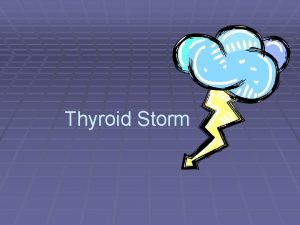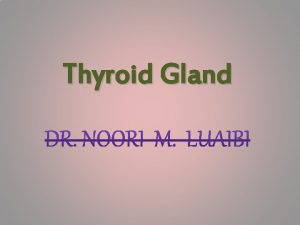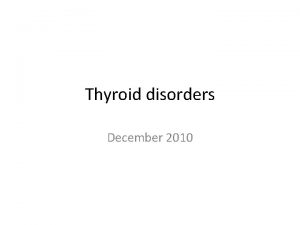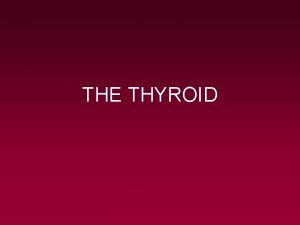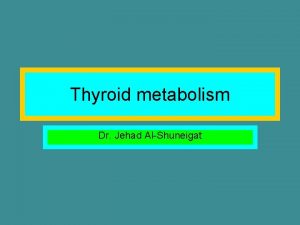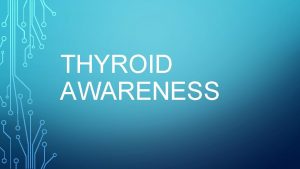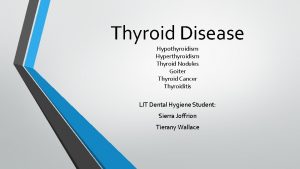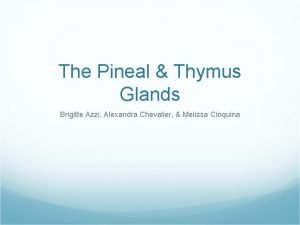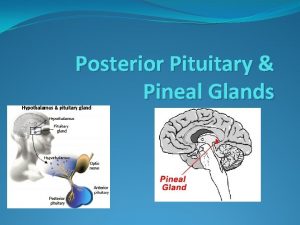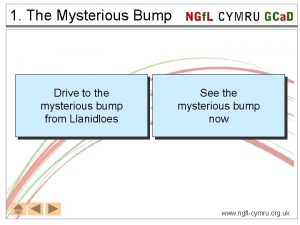The Mysterious Thyroid Pineal Glands Dr Dan Wagner






























































- Slides: 62

The Mysterious Thyroid & Pineal Glands Dr. Dan Wagner, RPh, MBA, Pharm. D. Herbalist www. askdrdanwagner. info

Thyroid gland

Facts about the Thyroid Gland ● Responsible for so much ● Largest endocrine gland ● Responsible for how body burns energy ● Sensitivity of hormones ● Produces calcitonin- places role in bone development ● TSH breaks down to T 4 (90%) and T 3 (10%). ● Can become sluggish (not mal-functioning) due to excess adrenal stress/tension

Facts about the Thyroid Gland ● Helps to make protein ● Thyroid can be dysfunctional, under-performing, hormone depleted, injured, stressed ● Two hormones secreted by hormone: T 3 & T 4 ● In conjunction with the hypothalamus and pituitary gland, the thyroid regulates body temperature, metabolism, and weight management. ● Lack of iodine plays an important role ● Danger of auto-immune diseases (Graves’ Disease and Hashimoto’s thyroiditis), thyroid cancer, goiters

Thyroid Care ● Optimal Biochemical Balance ● Improving Resistance to Microbial Insult and Balancing Gut ● Xenobiotic Protection ● Managing Stress…. ● Balancing adrenal function ● Reducing Chronic Degeneration ● Wellness, Diet & Rejuvenation

Hypothalamic-pituitary-thyroid axis ● The HPT axis (aka thyroid homeostasis or thyrotropic feedback control) is part of the neuroendocrine system responsible for the regulation of metabolism. ● The hypothalamus senses low circulating levels of thyroid hormone (T 3) and (T 4) and responds by releasing (TRH). The TRH stimulates the pituitary to produce thyroid-stimulating hormone (TSH). The TSH, in turn, stimulates the thyroid to produce thyroid hormone until levels in the blood return to normal. Thyroid hormone exerts negative feedback control over the hypothalamus as well as the pituitary

Hypothalamus ● The Brain’s brain ● Autonomic function (nerves) ● Effects our sleep-wake cycle ● Effects sex desire ● Body temperature (our thermostat) ● Appetite ● Related to smell receptors ● Hormone balance

Pituitary Gland ● Only the size of a pea, located at the base of the brain ● Secretes hormones regulating homeostasis ● Secretes trophic hormones that stimulate other endocrine glands ● Functionally connected to the hypothalamus ● It secretes hormones for sexual eminence and desires ● Helps to controls growth, blood pressure, some aspects of pregnancy, breast milk production, thyroid gland function, metabolism and water regulation in body

Adrenal Glands ● The adrenal glands are part of the endocrine system (2 small glands located on the top of the kidneys). ● The inner part (medulla) is responsible for producing adrenalin, a hormone that helps control blood pressure, heart rate, and sweating. ● The adrenal cortex (outer) produces: aldosterone hormone (salt & water), sex hormones (estrogen androgens), and cortisol (stress & inflammation). ● They regulate the levels of sodium in the body which increases energy, responds to stress(ors).


The Endocrine Society ● An int’l group of 13, 000 clinicians & researchers ● “There are known effects of a group of environmental pollutants termed ‘endocrine disruptors’ and define them as: compounds (natural or synthetic) which through exposure alters the hormonal and homeostatic systems that enable the organism to communicate with and respond to its environment. ” ● The statement is largely a large body of evidence accumulated in the last 2 decades on the relationship between env. exposure to a specific class of chemicals.

The Size of the Problem ● According to the Natl Health & Nutrition Exam Survey (NHANES) in a database of 17, 353 adults. ● 20 million people in US have clinical or subclinical hypothyroidism or hyperthyroidism (approx 9. 5%) ● TSH over 5. 01 m. U/L or TSH < 0. 3 m. U/L ● Thyroid autoimmune disease (TAD) is part of a growing phenomena of an epidemic. More than 24 million Americans have an autoimmune disease compared to 9 million with cancer. TAD comprises 78% of population (10% women, 3% men)

Hypothyroidism ● Hypothyroidism is a condition where thyroid gland does not make enough hormone A common but often unrecognized cause of agerelated decline in metabolic rate. Types of hypothyroidism: ● Congenital-this condition affects infants from birth; it is caused by inadequate thyroid hormone and is most commonly due to a thyroid gland that is missing ● Hashimoto thyroiditis- the most common cause of hypothyroidism in the United States; it is a chronic autoimmune condition in which the condition in which immune response targets the thyroid, causing inflammation and damage and the production of autoantibodies. ● Iodine deficiency: lack of this element (as iodide) diminishes the ability of the thyroid gland to make enough thyroid hormone.

Hypothyroid symptoms ● Whole body: fatigue, inability to exercise, lethargy, weakness, or feeling cold ● Gastrointestinal: bloating, constipation, or water retention ● Developmental: delayed puberty or slow growth ● Muscular: cramping or muscle weakness ● Mood: mood swings or sadness ● Hair: hair loss or dryness ● Also common: brittle nails, cold feet and hands, depression, dry skin, enlarged thyroid, high cholesterol, hoarseness, irritability, mental confusion, pallor, puffy eyes, sensitivity to cold, sexual dysfunction, sleepiness, slow heart rate, sluggishness, swelling, weight gain, or irregular uterine bleeding


An approach to hypothyroidism ● “Even though patients may have symptoms of hypothyroidism, it does NOT mean that they need to be started on thyroid medication. Looking at the cause of thyroid dysfunction is very helpful. T 3 is five times stronger than T 4. So, anything that can affect the conversion of T 4 -T 3 can give the patient symptoms of hypothyroidism. ” ● The following are factors that may cause an inability to convert T 4 to T 3…….

Blocking conversion of T 4 -T 3 ● Aging process ● Rx drugs (e. g. , beta blockers, chemotherapy, estrogen replacement, lithium, BC pills, phenytoin) ● Excess copper, low zinc ● Diabetes ● Heavy metals (e. g. , lead, mercury, dioxin, PCBs, pesticides, radiation, fluoride) OXIDATIVE STRESS ● Hormone imbalance- Low cortisol, low DHEA, stress ● Dietary factors (e. g. , excess alcohol, low CHO, low-fat, low-protein diet, soy)

Townsend Letter- Feb. 2016 ● “Fluoride at low levels disrupts thyroid function, according to a 2006 National Research Council (NRC) report and more recent studies. Fluoride accumulates in the thyroid and produces morphological changes. ● Numerous animal experiments show that high fluoride consumption reduces T 3 and T 4 and increases TSH levels. ● In 2013 study, Swait Singla of NRC reported correlations between fluoride content in drinking water and abnormal thyroid hormone levels.

Hypothyroidism Protocol ● Thyroid replacement-(synthetic T 4, natural T 4, T 3) ● Thyroid support-B complex, magnesium, iodine (kelp), selenium, copper, manganese, tyrosine, rosemary, zinc, vitamin B 12, Brewer’s yeast, vits. D, A, E. ● Adrenal support-Bovine adrenal cortex, licorice, zinc, Vit C, riboflavin, thiamine, B 6, pantothenic acid. ● Herbs: withania (ashwaganda), Myrrh ● Ways to improve things: treat underlying conditions such as like food allergies, gluten, heavy metals, nutritional deficiencies, exercise and minimize stress, optimize nutrition (avoid excess soy and isoflavones)

Side Effects of Synthroid ● Side effects can occur with Synthroid. Side effects are often a result of your body getting too much medicine. ● Rapid or irregular heartbeat; Chest pain or shortness of breath; Muscle weakness; Nervousness; Irritability; Sleeplessness; Tremors; Change in appetite; Weight loss; Hair loss; V/D; Excessive sweating; Inability to tolerate heat; Fever; Impaired fertility; Decreased bone density; Changes in menstrual periods; Leg cramps; Headache

Hypothyroidism, self-test ● Ways to improve things: to test yourself for an underactive thyroid, place a thermometer under your arm for 15 min, for 5 days. A temperature lower than 97. 6 degree F may indicate an underactive thyroid gland.

Hyperthyroidism ● Hyperthyroidism: too much thyroid hormone; sometimes called "overactive thyroid. “ ● Specific types: Graves disease- the most common cause of hyperthyroidism; it is a chronic autoimmune disorder in which the affected person's immune system produces antibodies that act like TSH, stimulating the thyroid to produce excessive hormone. ● Thyroid tumor: a small benign tumor may become insensitive to the negative feedback of low TSH and continue to produce excess thyroid hormone. ● Pregnancy, pituitary damage, abnormal stimulation

Hyperthyroidism Treatment ● Anti-thyroid meds, methimazole (Tapezole) and PTU which stop production of T 3 & T 4. ● The following foods help to suppress thyroid hormone production: broccoli, Brussels sprouts, cabbage, cauliflower, kale, mustard greens. They contain glucosinolates which may interfere with iodine absorption. ● Helpful nutrients: multi-vitamin-mineral formula, B-complex, extra vitamin B 1, B 2, B 6, Brewer’s yeast, vitamin C, essential fatty acids

Thyroid autoimmune disease (TAD) ● TAD is actually a cluster of diseases that include: ● Hashimoto’s thyroiditis ● Idiopathic myxedema (coma, severe hypothyroidism) ● Asymptomatic thyroiditis ● Endocrine exophthalmos (protrusion of eyeballs) ● Graves’ disease ● TAD is a complex autoimmune phenomena with 50% of patients also having other autoimmune syndromes ● (e. g. , diabetes, anemia, MG, lupus, celiac, MS, vitiligo)

What is Hashimoto’s Disease? ● Hashimoto’s disease is an auto-immune imbalance whereas something is causing inflammation in the body, causing the immune system to over-react to compensate, and ends up attacking the thyroid gland. ● Hereditary factor ● MAJOR TRIGGERS: ● Toxins, heavy metals, infections (bacterial, viral, fungal), pesticides, and other environmental factors can act as triggers.

OTHER Hashimoto’s triggers ● IODINE- Although iodine can be recommended to people with hypothyroidism, people with Hasimoto’s do NOT have an iodine deficiency, and taking extra will make it worse. ● GUT IMBALANCES- An overabundance of sugary and starchy foods, coupled with excess antibiotics, acid suppressants (PPIs), other Rx drugs, result in severe gut imbalance, enzyme deficiency, lower immunity. ● FOOD INTOLERANCES- gluten, soy, dairy, eggs ● SAD- Standard American Diet

The Hormones

Thyroid Function Tests

TSH (Thyroid stimulating hormone) (0. 4 -4. 5 ml. U/L) ● A TSH is the hormone which controls the thyroid gland. An excess or deficiency of TSH can affect energy levels, mood, and many functions. When the thyroid gland begins to fail, due to primary disease, TSH levels increase. ● This condition is called primary hypothyroidism, meaning low function of the thyroid gland. ● If TSH levels decrease, the gland is overactive producing too much thyroid hormone. This is called primary hyperthyroidism. Thus, TSH helps distinguish a sick person (with thyroid problems) from a sick person (without thyroid problems).

Triiodothyronine, serum (T-3) (100 -200 ng/d. L) ● T 3 is one of the 2 hormones containing iodine produced by the thyroid gland. T 3 helps to regulate metabolism (how nutrients are broken down, distributed and utilized) by increasing the rate of chemical reactions. T 3 -uptake measures how much T 3 is attached to its carrier protein in the blood, thus it measures the level of ‘free’ (unbound) hormone.

T 3, Reverse (r. T 3) (8 -25 ng/d. L) ● This test measures the amount of reverse T 3 that is produced. The production of r. T 3 usually takes place in cases of chronic or extreme stress, trauma and surgery. It appears that the increased production of r. T 3 is due to the body’s inability to clear r. T 3, as well as elevated cortisol. (See cortisol, T 3, free T 3)

T 4, Free (0. 8 -1. 8 mg/d. L) ● Free thyroxine (free T 4) tests are used to help evaluate thyroid function and diagnose thyroid diseases, including hyperthyroidism and hypothyroidism, usually after discovering that the TSH level is abnormal. T 4 is converted to T 3 hormones by the body naturally, but sometimes the body is unable to make this conversion. When your body does not covet T 4 to T 3 you could become deficient in thyroid hormones ● HIGH: hyperthyroidism, neonates, acute thyroiditis, hepatitis, liver disease. LOW: hypothyroidism or mild sub-clinical hypothyroidism, low protein intake

Thyroxine Binding Globulin TBG ● The TBG blood test measures the level of a protein that moves thyroid hormone throughout your body. TBG is non-harmful and may be inherited or acquired. ● HIGH: Acute porphyria (abnormal heme production), hypothyroidism, pregnancy (TBG levels are normally increased during pregnancy) ● LOW: hyperthyroidism, malnutrition, nephrotic syndrome, chronic renal failure, liver disease, HIV/AIDS, systemic illness, Cushing syndrome

Thyroglobulin antibodies ● Antithyroglobulin antibody is a test to measure antibodies to a protein called thyroglobulin, which is found in thyroid cells, responsible for carrying thyroid hormones in the blood ● HIGH: Graves disease, Hashimoto’s thyroiditis, hypothyroidism, systemic lupus (SLE), type 1 diabetes, thyrotoxicosis locking its production.

Thyroid Peroxidase (TBO) ● Thyroid antibody testing is primarily ordered to help diagnose an autoimmune thyroid disease (e. g. , Hashimoto’s disease, Graves disease, cancer) and to distinguish it from other forms of thyroid dysfunction. ● It may be ordered to help identify a goiter or other signs and symptoms associated with high or low thyroid hormone levels and as a follow-up to normal TSH, T 3, T 4 testing.

Thyroid Peroxidase (con’t) ● HIGH: Elevated TPO levels are found in virtually all cases of Hashimoto's disease and they will also be raised in 65% of patients with Graves disease. ● Ways to improve things: eat a gluten-free diet, eat more organic foods ● Helpful nutrients: selenium (Brazil nuts), vitamin C, vitamin D, iodine, progesterone (see a qualified practitioner)

Too much IODINE may ad-versely affect thyroid function ● Iodine is a component of thyroid hormones, and deficiency can lead to goiter and hypothyroidism. ● However, excess iodine can lead to thyroid dysfunction including hyper or hypo- thyroidism and possibly autoimmune thyroiditis. ● Take under supervision of a qualified health care practitioner and get a urine test if needed. ● Do not believe that any iodine is a danger (150 mcg daily, 290 mcg for pregnant women) ● Best sources: Lugaol’ soln, supplement, Himly salt

How to Love Your Thyroid with Essential Oils

Best Essential Oils ● THYROID NEEDS A BOOST (Grave’s)? ● Lemongrass ● Clove ● Myrrh ● Peppermint ● THYROID NEEDS TO SLOW DOWN (Hoshimoto’s)? ● Myrrh ● Lemongrass ● DOTERRA: combine 1 drop of oil(s) and apply on base of the throat and/or reflex points on the feet)

Frankincense ● This is the ‘king’ of all oils and can help with many different symptoms associated with an underactive thyroid. ● One is a weak digestive system (constipation, indigestion). ● Place a drop of frankincense under your tongue at bedtime to help promote healing, relief dry skin, balance hormones, and reduce stress at night. ● It can be diffused and rub topically on cysts, fibroids, or goiter.

Summary of Mechanisms of Thyroid Disruption ● Inhibition of iodide uptake at the cellular membrane ● Synthesis inhibition via thyroperoxidase ● Binding of transport protein (TTR) in bloodstream ● Altered hepatic phase catabolism ● Alteration of T 4 metabolism ● Alteration of transport across TSH receptor ● Oxidative stress and environmental disruptors (e. g. , pesticides, GMOs, herbicides, food additives & preservatives, heavy metals, radiation & Esmog)

Summary ● Thyroid disease, including autoimmune thyroid disease and thyroid cancer, has a substantial incidence in the U. S. The incidence is growing faster that can be explained by merely an increased diagnosis or better medical technology. ● Thyroid disruptors consisting mainly or heavy metals, pesticides and persistent organochlorine compounds pollute our environment and are measurable in US. ● Although there is no currently available way to predict the effects of a complex body burden of these disruptors, there is much more need for investigation

What is the Pineal Gland? ● The pineal gland is an endocrine organ located in the brain. It is said to be the ‘seat of the soul. ’ ● Also referred to as the “Third Eye. ” ● The pineal gland is believed to be involved in reaching higher consciousness, acting as a gateway (bridge) to dimensions beyond the brain-created reality. ● To tap into this power, one must strengthen its function via detoxification and proper nutrition. ● The process of detoxification is an essential place to start to exploit our full spiritual capabilities.

What does the Pineal Gland do? ● The famous philosopher Descartes described the pineal gland as the “principal seat of the soul. ” You’ve probably heard of this gland being the “third eye, ” a mystical chakra point residing right in the middle of your eyebrows. It turns out these ideas aren’t too far off. The small, rice-sized, pinecone-shaped endocrine organ known as the pineal gland sits alone in the middle of the brain and at the same level as the eyes.

What Does the Pineal do? ● How you think and feel every day depends on the pineal gland. As the producer of the hormone melatonin, the quality and duration of your sleep relies on how well it produces this hormone. This tiny organ regulates your daily and seasonal circadian rhythms, the sleep-wake patterns that determine your hormone levels, stress levels, and physical performance.

What are the main toxins? ● Researchers are finding that many people, due to poor diet and pesticide & chemical-laden foods and environmental toxins (such as fluoride) the pineal gland becomes exposed to more toxins and nanoorganisms than ever before. ● These form calcium shells around themselves for protection from our immune system (auto-immunity) that results in calcification of the pineal gland. ● This calcification hinders when we try and tap into our esoteric capabilities (e. g. , yoga, meditation, cannabis)

1. MELATONIN ● The pineal gland already produces the hormone melatonin, which affects the body’s circadian rhythms of waking and sleeping. ● Melatonin is also associated with relaxation and visualization , and people often take it as a sleep aid or to help over come jet-lag due to travel. ● It is suggested to start with the smallest dosage that is effective, than work up to 10 or 20 mg. ● Melatonin has is an effective anti-oxidant (lowers oxidative stress) and is used in cancer therapy (lung)

2. OREGANO OIL & NEEM EXT. ● Both oregano oil and neem oil extracts help in the purification process, helping to remove existing calcification of the pineal gland, in addition to purifying the body’s systems. (especially the endocrine system). ● In the Western world use of oregano is becoming a holistic way of fortifying the immune system (antibacterial, anti-fungal and anti-parasitic).

3. Raw Cocoa ● Raw, organic chocolate in its the purest form can help to detoxify the pineal gland because of cocoa’s high antioxidant content. ● Cocoa is also reported to stimulate third eye. ● Raw cocoa is considered a Superfood. ● Dosage: 1 -2 tablespoons per day. Add to smoothies, elixirs, cereal, trail mix and/or desserts.

4. Chlorophyll-rich Superfoods ● Chlorophyll has been considered as the best allaround universal detoxification agent. ● Supplements such as chlorella, spirulina, wheatgrass, kamut, blue-green algae are examples of chlorophyllrich Superfoods (more so than eating leafy green plants). ● These supplements assist in decalcification of the pineal gland due to their strong detoxification properties.

5. Raw Apple Cider Vinegar ● A natural detoxifier, raw apple cider vinegar helps decalcify the pineal gland due to its malic acid properties. ● Malic acid is a organic compound that gives fruits their sour taste. ● When taken as a supplement, it supports the digestive system and helps the body detoxify. ● Apple cider vinegar has many other health benefits.

6. Zeolite ● These volcanically-produced crystals have recently been discovered as a powerful way to detoxify your body. They break down hardened calcium that forms around toxic metals in tissue and removes these heavy metals from the body.

7. Iodine ● We have all been exposed to excessive levels of sodium fluoride due to the fluoridation of our water systems. This is one of the leading causes of pineal gland toxicity and calcification of the pineal gland. ● Iodine naturally occurs in plants such as seaweed and table salt (leads to high blood pressure). Supplementation with Lugol’s, nascent, becomes necessary, and is essential of thyroid gland health. ● Iodine effectively improves the removal of sodium fluoride via the urine.

8. Vitamins K 1/K 2 ● Vitamins K 1/K 2 (which can be derived from organic blue fish oil) allows the body to remove calcium from various location throughout the body, such as the pi neal gland the arteries. ● Instead of eliminating calcium from the body (as iodine does), vitamins K 1/K 2 places the calcium in the most needed areas such as teeth and bones. ● It has been know to reverse the damage done by calcification which results in diseases such as osteoporosis and atherosclerosis. Take with vitamins A/D 3.

4 Ways to Activate the Pineal ● 1. Get Out and Into the Sun ● Sun exposure kick starts the pineal gland stimulates the mind. Any type of light exposure, either directly or indirectly, activates the pineal gland, prompting it to produce serotonin; the neurotransmitter responsible for mood and energy levels. This is why it’s crucial to avoid light after the sun goes down, because you need your pineal gland to produce melatonin and suppress serotonin. This process can only be accomplished by reducing E-smog and radiation.

4 Ways to Activate the Pineal ● 2. Sleep in Complete Darkness- A dark environment ensures your pineal gland produces enough melatonin to ensure good, restful sleep. Tricking your pineal gland into thinking it’s daytime, confusing your wake/sleep cycle. ● 3. Sun Gazing- Sun gazing is perhaps one of the most controversial exercises you can do to activate the pineal gland. Here’s the basics of the practice: within the first 15 minutes of sunlight at the beginning of the day and then the final 15 minutes of sunlight at the end of the day. ● 4. Meditation ● The pineal gland responds to the bioelectric signals of light and dark, and meditation activates this bioelectric energy. With practice, you can learn to direct this energy to this highly-sensitive organ.

8. What else can help boost pineal gland function? ● Boron/Borax is effective in removing fluoride. ● Cilantro ● Goji berries ● Watermelon ● Bananas ● Hemp seeds ● Coconut Oil ● Chaga mushrooms ● Lemons and alkaline foods

The 5 Best Foods to Detox the Pineal gland ● 1. WATER CRESS ● 2. PINEAPPLE ● 3. COCONUT ● 4. AVOCADOS ● 5. BANANAS

The Crown Chakra 7 th ● The 7 th and so-called “crown chakra, ” is situated at the highest point of the head-exactly where the ruler’s crown ought to be. ● From the standpoint of the autonomic regulation system (endocrine) it is related to the epiphysis-pineal ● The energetic function of #7 is to give our entire system (physical, mental, spiritual) orientation and regulation, and keep it in a reasonable order. ● It’s responsible for cyclic courses- day & night- sleep and being awake- even the rhythm of living & dying.

Crown Chakra 7 (con’t) ● The 7 th chakra has connection to our sense of balance (vertigo is out of order), to the tension of the muscles, and all the functions that usually run subconsciously and giving us the feeling of who, what, how and what we are to our environment. ● In a spiritual context, chakra 7 is our connection to heaven, Nirvana, or the pot of gold at rainbow’s end. ● It is the destination of Kundalini energy rising from the base to the crown. Christians believe it is the Holy Spirit and how it came to the disciples from above.

4 Major Conflicts of Pineal #7 ● Conflicts arise in chakra 7 when a person refuses to listen to their ‘inner voice. ’ They may refuse to choose morality as their guideline, or refuse to acknowledge a higher self ands how it brings meaning to life. ● MISTRUST- They make everything questionable. They don’t want to open up or reach out and join hands. ● MATERIALISM- “I only believe in what I can touch” ● UNABLE TO FACE REALITY- They have an idea of higher guidance, but unable to integrate their visions. ● JUDGEMENTAL- Most common. They set up their own rules. They are the smartest, individualistic.

Dr. Dan Wagner at Wildwood Wellness BLOG: askdrdanwagner. info 2536 B Wildwood Road, Box 279 Wildwood, Pa 15091 Phone: 412 -486 -6263 Email: askdrdanwagner@gmail. com
 Dopamine agonists
Dopamine agonists Pineal and pancreas glands
Pineal and pancreas glands Holocrine
Holocrine Isthmus size
Isthmus size Thyroid and parathyroid glands histology
Thyroid and parathyroid glands histology Renin target organ
Renin target organ Seat of the soul pineal gland
Seat of the soul pineal gland Fisiologia de la glandula pineal
Fisiologia de la glandula pineal Pituitary gland and pineal gland spiritual
Pituitary gland and pineal gland spiritual Pineal gland secretes
Pineal gland secretes Pineal gland pituitary gland
Pineal gland pituitary gland Thyroid parafollicular cells
Thyroid parafollicular cells Olho de horus e glandula pineal
Olho de horus e glandula pineal Beyin körpüsü
Beyin körpüsü Pineal tumor
Pineal tumor The mysterious box short story
The mysterious box short story The mysterious fall of the nacirema
The mysterious fall of the nacirema Mysterious ziggy
Mysterious ziggy Four primary tissue types
Four primary tissue types Glands in integumentary system
Glands in integumentary system Pea size glands flanking the vagina
Pea size glands flanking the vagina Major endocrine glands male and female
Major endocrine glands male and female Major endocrine glands male and female
Major endocrine glands male and female Plicae digestive system
Plicae digestive system Gastric glands
Gastric glands Sialactasis
Sialactasis Mucus vs serous glands
Mucus vs serous glands Types of salivary glands
Types of salivary glands Propolis block factories
Propolis block factories Glands of littre
Glands of littre Coiled glands
Coiled glands Difference between endocrine and exocrine glands
Difference between endocrine and exocrine glands Von ebner duct
Von ebner duct Types of salivary glands
Types of salivary glands Female hymen
Female hymen Are endocrine glands ductless
Are endocrine glands ductless Sebum function
Sebum function Mammels
Mammels What is gonads
What is gonads Mucous neck cells
Mucous neck cells Where is the sperm produced
Where is the sperm produced The purified lymph with lymphocytes and antibodies added
The purified lymph with lymphocytes and antibodies added Endocrine molecules
Endocrine molecules Endocrine system function
Endocrine system function Oxyphil
Oxyphil Corpus gastricus
Corpus gastricus Classification of exocrine glands
Classification of exocrine glands Merocrine gland
Merocrine gland Cardiac muscle striations
Cardiac muscle striations Whats the difference between endocrine and exocrine glands
Whats the difference between endocrine and exocrine glands Hypothal
Hypothal Submandibular gland excision
Submandibular gland excision Brush border enzymes
Brush border enzymes Sialography
Sialography Colon
Colon Intercalated ducts
Intercalated ducts Cytocrine glands
Cytocrine glands Endocrine glands
Endocrine glands Testing cranial nerves
Testing cranial nerves Submandibular gland excision
Submandibular gland excision Minor salivary glands
Minor salivary glands Flask shaped gland
Flask shaped gland Cynocephalus variegatus
Cynocephalus variegatus
